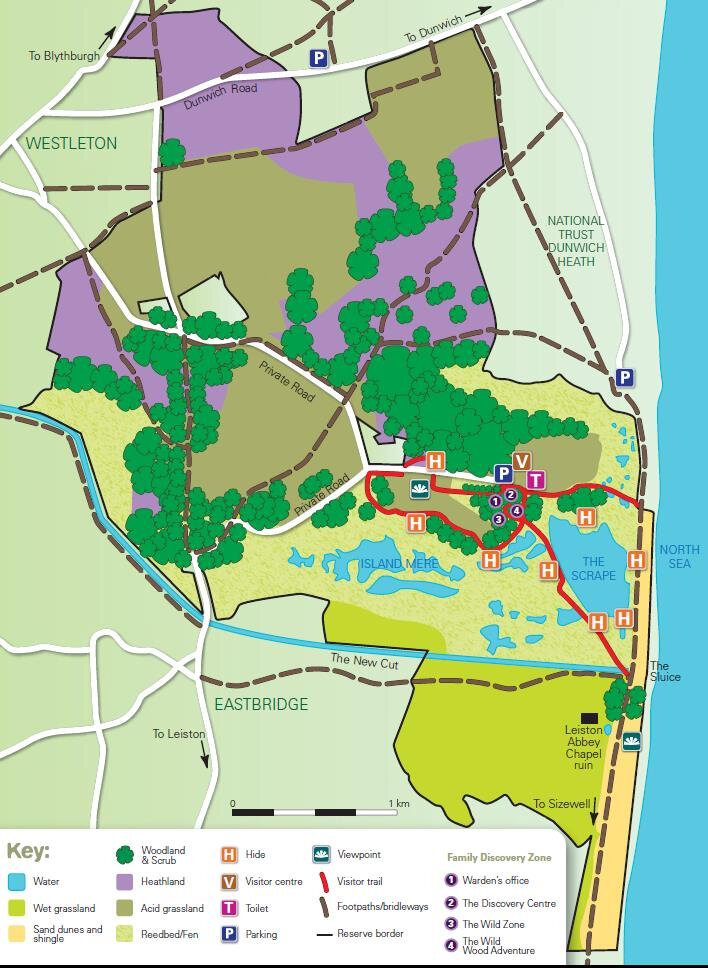The Nature and Wildlife Group will resume its outdoor shoots at Minsmere Nature Reserve out on the Suffolk Coast.
Minsmere is a 2,500 acre site which has been managed by the RSPB since 1947 covering reed beds, grassland, woodland, and areas of beach and shingle. It is within the Suffolk Coast and Heaths Area of Outstanding Natural Beauty and is conserved as a site of Special Scientific Interest.
Minsmere is home to Nightingales, Marsh Harriers, Bearded Tits, Bitterns, Avocets, and many other species. There are easy paths through woodland, heathland, and reed beds, past coastal lagoons and on to the beach.
Special instructions
1) Ensure you wear sensible clothing for the weather and the appropriate footwear.
2) Please read the Health & Safety guidance for nature & wildlife shoots before joining the shoot
3) Meet in the car park by 10:00am for a collective briefing before the shoot..
Before becoming a nature reserve, the area was the site of an ancient abbey and a Tudor artillery battery. The marshes were reclaimed as farmland in the 19th century but were re-flooded during World War II as a protection against possible invasion.
The reserve has a visitor centre, eight bird hides and an extensive network of footpaths and trails. Potential future threats to the site include flooding or salination as climate change causes rising sea levels, coastal erosion and possible effects on water levels due to the construction of a new reactor at the neighbouring Sizewell nuclear power stations.
Please note the visitors centre, shop and hides are currently closed although all facilities are expected to be re-open before our shoot on Monday 12th April. As the cafe may/may not be open it would be advisable to bring a packed lunch. Toilets are open as normal, but you will be required to wear a mask when using them and you are also recommended to bring along your own antiseptic hand gel.
Entry is free for RSPB members. For those that are not members of the RSPB there is normally an entry charge and car parking fees to pay.
Please note:
Don’t forget to check the arrangements before setting out if there has been extreme weather overnight.
About the NDPS Nature & Wildlife Group
The Nature and Wildlife Group is the newest of the Society’s Special Interest Group being formed in 2019 in response to the demands from members to include outdoor shoots in the annual programme for this genre of photography. If you want to learn more speak to Keith Garnham who is currently the leader of the group.
Monthly shoots are planned so that members can explore all that Norfolk has when it comes to wildlife habitat. It has a wide variety of land types it has chalk rivers, ancient woodland, fertile farmland, fen, broad, and breck. A coast line that is full of variety, internationally important wetlands, marshes, and sandy beaches. The shallow North Sea is a powerhouse of potential feeding for visiting mammals, fish, and birds all that are interconnected in the circle of life.
From time to time, the Group also plans to organise specialists shoots further afield such as the visit in October 2019 to witness the deer rut at Bradgate Park in Leicestershire.
Please remember, our group can only be as good as the input made by its members so if you are willing to organise or lead any kind of event that you think will be of interest to members, please step forward. Please don’t be shy – all offers of help will be greatly appreciated…!
About Norfolk’s Nature & Wildlife
The Norfolk Coast is one of the major flyways for migrating birds in the spring, summer, autumn and winter. Change is the constant that provides the visitor with an opportunity to see and photograph something different in every season.
There is no off-season on the Broads. Local visitors and those from further afield are drawn to the area all year round, and it’s easy to understand why. This is the perfect place for a mini safari, right on your doorstep.
Spring - Adders, Porpoise and swallows
The adder, Britain’s only venomous snake makes its home in the heathland and dunes near Horsey. And if you’re lucky, you’ll catch sight of one, as the males emerge from hibernation a month earlier than the females. This is also the best time of year to spot the rare and elusive harbour porpoise off the coast. Late May sees an abundance of invertebrate life, like damselflies, flying close the surface of the water. While the inward migration of huge groups of swallows are best seen from conservation centres like the one at Ranworth Broad.
Summer - Hawks, Harriers and butterflies
Nocturnal, shy and extinct across much of Europe, the best time to catch a glimpse of Britain’s largest native crayfish, The White Clawed, is from July to September in the river Wensum. Now only seen in the Broads, Britain’s largest butterfly, the Swallowtail, emerges in late May. One of the best ways to see it is very early on a bright, summer’s morning at Hickling Broad. The impressive Marsh Harrier is another of the Broad’s conservation success stories. Once extinct in Britain, it now nests throughout the area. Mid to late summer also brings a carpet of Purple Sea Lavender blooms across the marsh.
Autumn - Seabirds, sea pups and bluetails
Said to be the best time for for watching seabirds, rare warblers and red-flanked bluetails come inland for the winter, it’s also fungi season, so there’s an array of mushrooms and toadstools making their home on old wood and loamy soil. From the attractive but poisonous red colouring of the Fly Agaric to the edible Chicken-of-the-Woods. The highlight of the year around the coast at Horsey is the start of grey seal pupping season – from October to early February, mothers come ashore, have their babies and nurse them, right on the beach.
Winter - Waterfowl, geese and deer
Chilly North Sea winds don’t deter wildlife watchers during the coldest months of the year. The cacophony of waterfowl overwintering on the salt marshes draws hardy spotters with binoculars.
The Norfolk coast is the best place to see a rarer, dark-bellied variety of the vocal Brent Goose. It’s also a good time of year to spot deer, especially the smaller, non-native, Chinese Water Deer which favours a wet, marshy environment.

